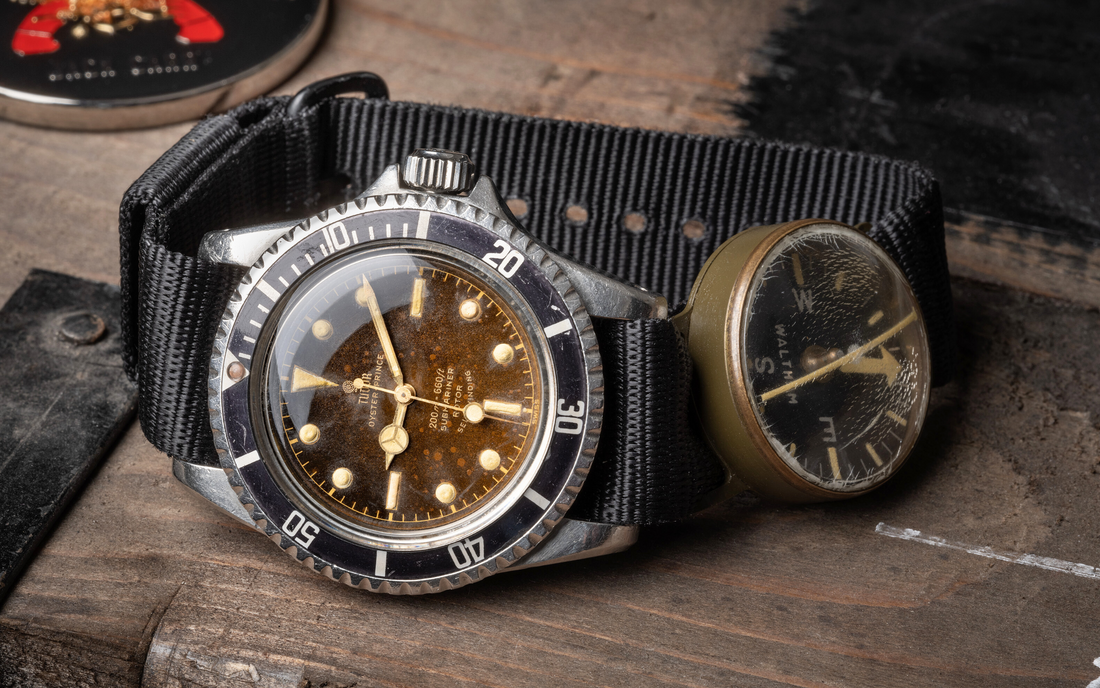From Waltham To Suunto & Now W.O.E., A Wrist Compass Is Essential Gear For Countless Special Operators
While the tools of warfare have developed rapidly over the past sixty years, some gear has remained virtually unchanged, timeless tools that are as effective in 2024 as they were in 1964. Among those essential items are the wristwatch and the wrist compass, both utilized extensively as tools by Intelligence and SpecOps personnel throughout the past six decades.

A US Navy SEAL in Vietnam wears a Rolex or Tudor Submariner with a wrist compass. (Photo Credit: Herb Ruth Collection)
We often discuss the importance of timekeeping in operational scenarios, but navigation is another equally mission-critical element. The archetypal image of the Vietnam-Era SEAL or a MACV-SOG operator almost always includes not only a watch but also a wrist compass, worn on the same strap. Often overshadowed by the watches they accompany, wrist compasses are useful tools favored by divers and special operators, backed by an intriguing history that stretches from the Vietnam War until today.

A prototype of the W.O.E. Submersible Wrist Compass worn with a Tudor Pelagos FXD. (Photo Credit: Brock Stevens)
In this Dispatch, we’ll explore the use of wrist compasses in operational scenarios both then and now, as well as how that rich heritage informed the development process for the W.O.E. Submersible Compass.
Wrist Compasses & Special Operations - A Brief History

The US Navy Scouts and Raiders, a predecessor to the US Navy SEALS, were formed during World War II.
While the concept dates back to ancient China, the compass as we know it today started seeing widespread use as a tool by mariners navigating at sea as early as the 1100s. Military organizations began issuing smaller, more portable compasses en masse to ground-based troops as early as the First World War, a conflict that also saw the widespread adoption of wrist-worn as opposed to pocket watches.
Modern SpecOps finds its roots in the Second World War. During this period, the nascent Navy Scouts and Raiders from the United States and British Special Air Service (SAS) and Long Range Desert Group (LRDG) commandos utilized lensatic compasses with built-in sighting mechanisms for wayfinding in challenging terrain.

Ralph Bagnold of the LRDG designed the Bagnold Sun Compass during the Second World War. (Photo Credit: National Army Museum)
While accurate, these compasses were typically too large for use on a watch strap and lacked water resistance, factors that would become increasingly crucial as maritime special operations grew to include combat diving and other amphibious modalities. By the early 1950s, dive watches including the Blancpain Fifty Fathoms and Rolex Submariner had already become essential parts of any military diving load out. Like watches, the compass would also need to adapt to fit the needs of an evolving military.

An astronaut and aquanaut on all three US Navy SEALAB experiments, Malcolm Scott Carpenter famously wore a Rolex Submariner with a wrist compass in diving scenarios. (Photo Credit: US Navy)
Underwater compasses had been used by divers for decades by that time but were cumbersome for clandestine maritime operators after leaving the water. In the 1960s, numerous scuba diving brands including Aqualung, Dacor, and Scubapro produced simple oil-filled compasses designed to slide over a watch strap. These diving-specific compasses famously appear in photographs alongside watches like the Rolex Submariner and the Doxa Sub 300/300T during the US Navy’s SEALAB experiments.

US Navy SEAL Steve Jewitt, nicknamed “The Walrus”, wearing an issued Tudor 7928 alongside a Waltham wrist compass. (Photo Credit: WalrusTactical)
Far from the undersea world, the US Military’s answer was a straightforward wrist compass produced in many cases by Waltham and intended for use alongside a navigator’s issued A-11 or similar wristwatch. Given the sizing norms of watches during the period when many tool watches measured 32 millimeters, the compass came equipped with 16mm canvas and later nylon straps. Designed for use by downed pilots, these compasses, which were initially marked “Waltham” and later “W.C.C.” for Waltham Clock Company, would not see widespread use until the Vietnam War when SEALs brought them into action alongside their issued Tudor 7928s.

A Vietnam-Era Seiko and Waltham wrist compasses, all of which were utilized by MACV-SOG. (Photo Credit: W.O.E.)
The SEALs were not alone in their adoption of the mil-spec Waltham. Army Special Forces operators assigned to MACV-SOG also selected the brass wrist compass for use alongside their issued Seiko watches. When we interviewed John Stryker Meyer, a legend in the SF community, he said that some of his fellow Recon Company soldiers added a W.C.C. compass to the strap, but he preferred the traditional compass around his neck. For special operations forces, the need for a more portable compass stemmed from the level of autonomy and individual responsibility entrusted to each operator. These Waltham compasses, which are still relatively available through surplus or militaria channels, are becoming increasingly collectible due to their SpecOps associations.

Retired US Navy SEAL Dave Hall wearing a Cammenga wrist compass alongside a Seiko 6309. (Photo Credit: Dave Hall)
After Vietnam, many continued to wear their Waltham compasses into the Cold War, with SEALs including our friend Dave Hall sometimes opting for older W.C.C. compasses over more modern options out of reverence for his SEAL mentors. Issued escape and evasion kits still included the Waltham in many cases, but some frogmen of the 1980s opted for diving-specific compasses from brands like Silva and Tekna.

The Cammenga J582 (left) and Suunto M-9 (right) are among the most popular wrist compasses among special operators today.
Over time, several brands stepped up to produce simpler and cheaper compasses which evolved along with the world of watchmaking. Starting in the 1990s, the NSN or Nato Stock Number formerly held by Waltham was taken over by Stocker & Yale with a modernized version of the W.C.C. with tritium gas tube illumination housed within an aluminum case. In 2004, Cammenga, already a maker of many issued compasses, purchased the rights and continues to manufacture the mil-spec wrist compass, now called the J582, for the US Military. While it is an effective tool, the Cammenga is not designed for extended diving or swimming operations.

A USAF Pararescueman wears a G-Shock DW6900 alongside a Suunto Clipper compass in Afghanistan in 2009. (Photo Credit: Michael Yon)
A more modern option that has also been issued to and privately purchased by members of the US Military is the Suunto M-9, though it is typically worn alone on the opposite wrist as opposed to with a watch. For wear on a watch strap, Suunto’s Clipper compass and a similar design from Marathon are also common options for military personnel. All offer significant utility for special operators, but most lack the refinement to go toe to toe with watches from brands like Rolex, Omega, Tudor, and Seiko.
The W.O.E. Submersible Wrist Compass

A core principle of everything we do at W.O.E. is honoring our heritage. Inspired by the link between tool watches utilized by SpecOps and capable wrist compasses, we set out to design a modern compass measuring that also calls back to the W.C.C. wrist compasses historically used by SpecOps. The result of over two years of prototyping and extensive testing by divers and SpecOps personnel, the W.O.E. Submersible Wrist Compass is a capable tool that celebrates the heritage of our community.

With a custom dial featuring C3 Super-LumiNova, a grade two titanium case, individual water resistance testing to 100 meters, and slim 24.5mm wide by 12mm thick dimensions, the W.O.E. Submersible Wrist Compass is a capable tool that also looks the part alongside tool watches from Seiko, Rolex, Omega, and Tudor. Click HERE to learn more about the W.O.E. compass.
If you enjoyed this article, please consider signing up for our weekly free newsletter for further updates HERE.
Read Next: The Dive Watch - How The Military Helped To Shape History’s Greatest Tool Watch









9 comments
Who makes a good one? Most (even $$$ like PDW) are cheap Chinesium in an expensive housing (titanium is what the cool kids want!).
Great article, although I do believe Scott carpenter is wearing a water temp gauge on his strap with the Submariner, not a compass.
Very handy when hunting, not so much for navigation, but as a quick check on prevailing wind and knowing where the sun will rise. This is especially critical when hunting waterfowl.
I could be wrong, but I believe the WWII picture from the South Pacific Theater of Operations in this article is of the U.S. Army Alamo Scouts. General Douglas MacArthur directed the stand up of this 6th Army unit with the primary mission of Special Reconnaissance. Their most utilized method of infiltration/exfiltration was by submarine and/or PT Boat, which most likely would require a good Watch Compass. The Alamo Scouts were also credited with the rescue of over ~197 Allied POWs during the war. The Alamo Scouts also included a more Native American and Philippine Soldiers than any Army unit during the war, which makes it one of the units today’s Army Special Forces draws their linage from.
I still own a wrist compass from my Army days. Our team chief (101st Pathfinders) broke out a box of them. I think I still have it somewhere in a Pelican case storing my service gear. I believe it was a Cammenga on an independent strap. I relied on the standard Army lensatic compass alongside the DAGR GPS unit we were issued. Looking back, my lack of faith in GPS would look silly up until my 2007 Iraq tour. Garmin Foretrex 401 on my right wrist in subsequent tours with Suunto Core All Black digital watch on my left. Two of my most cherished utilitarian issued items.
Ordered the WoE Submersible compass. Perhaps, I’ll put it on my Suunto Core watch and take it out swimming in the Sea of Cortez. Why not. Nostalgia is a powerful emotion.